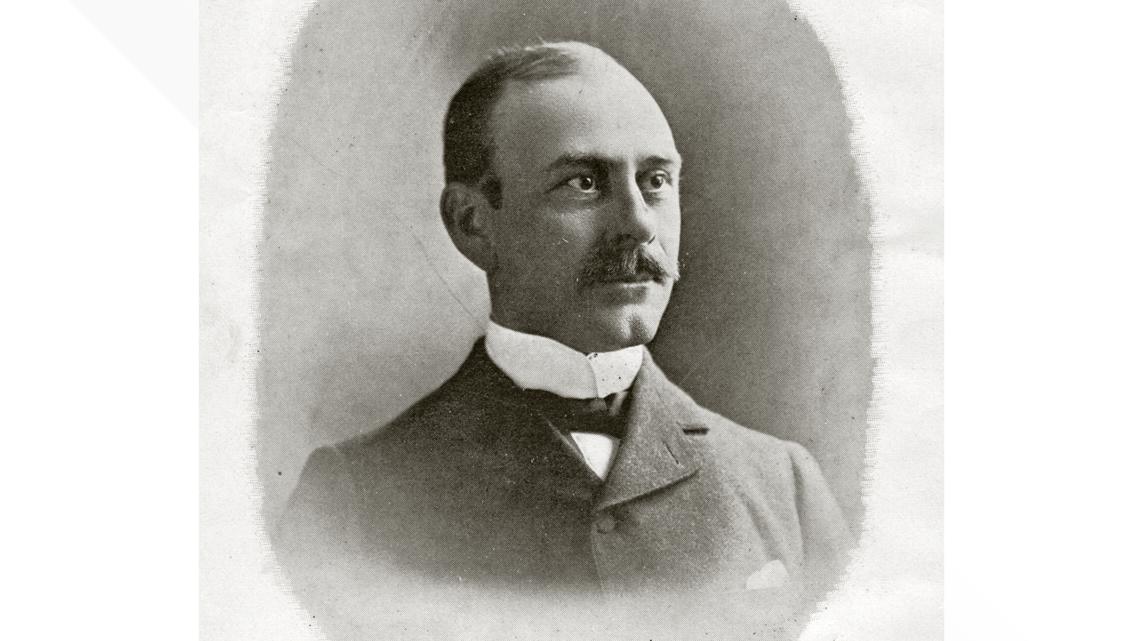[ad_1]
At Highlands Ranch Mansion, the unexplained and unsettling has become routine. But is it haunted? Historic Programs Coordinator Susie Appleby isn’t sure.
HIGHLANDS RANCH, Colo. — Halloween is days away, and some of us like a good scare this time of the year. Over at the Highlands Ranch Mansion, the unexplained and unsettling has become routine.
“Definitely the mansion deserves a very prominent page in any Colorado history book,” said Susie Appleby, Historic Programs Coordinator with the Highlands Ranch Mansion.
The mansion was first built in 1891 by Samuel Allen Long, coming to start a new life in Colorado.
In the decades since, it’s housed even grander residents.
“Our owners were some of Colorado’s greatest movers and shakers. They came from some of the state’s wealthiest and most influential families,” Appleby said.
Appleby said working at the mansion, there’s one question they get asked over and over.
“Is the Highlands Ranch Mansion haunted?” Appleby said. “We don’t know. But do we have a lot of unexplained stories? Yes, we absolutely do.”
For years, people have spotted spirits, heard voices and seen ghosts. And despite one of the owners’ involvement in a murder at the Brown Palace Hotel in 1911, Shaun Boyd, Curator of Archives with History Colorado, said the mansion has only marked one confirmed death in its 130 years.
“Lawrence Phipps died in the house. He’s the only person not accused of being a ghost in the house, but as far as I know, he’s the only person who actually died in the house,” Boyd said.
Historic photos from inside Highlands Ranch Mansion
But Appleby said for those working here, the unexplained has become expected.
“Most recently, myself and two other coworkers, we were in the office in the middle of the day working at our desk and we heard a female say ‘hello?’ Just like that in between us. There’s no way to explain that other than, it just came out of the air in between us,” Appleby said.
Items in rooms people never enter will be moved around. Footsteps and calls of “hello” when workers are alone in the home go unexplained.
“There had been other paranormal teams that were allowed in there over time. They have recorded orbs moving down the big, long gallery,” Boyd said.
“We have a lot of stories going down this hallway of a little girl looking out the windows. Many people have seen that,” Appleby said. “We also have, I think our most commonly reported spirit is that of a little boy who has breathing issues.”
Appleby has spent years researching the mansion’s previous owners, wondering if their spirits are still lingering behind. She finds the strange happenings here to be odd, not frightening.
“I have never been scared. I’ve definitely been puzzled and had things, so many things happen to me that I couldn’t find a reason for, but I’ve never been scared except for one time, I did absolutely get scared,” Appleby said.
She said her coworker was downstairs in the restroom when something whistled loudly in her ear.
“I was saying, ‘what do you mean somebody whistled? Was somebody in the bathroom?’ No, no one was in the bathroom,” Appleby said. “And as we were doing this back and forth, we suddenly heard two very loud and very long whistles come just immediately outside our office, and we froze.”
The pair searched. No one was there.
Still, Appleby said after everything she’s seen and heard, she’s not convinced the mansion is haunted.
Staff here won’t convince you otherwise.
“We always say to people, we’re going to tell you our unexplained stories, and then we’re going to leave it up to you to decide what you believe,” Appleby said.
For years, the Highlands Ranch Mansion didn’t share their spooky stories along with the history.
“We were worried that if we talked about this side of its history that it might harm its reputation. And what we found instead was because we weren’t talking about it, it didn’t mean that everybody else stopped talking about it. In fact, it was quite the opposite,” Appleby said. “People were talking about it but there was a lot of misinformation that was being spread. So for us, we decided that we need to start talking about this because then, we can kind of take control back of the messaging and do our best to prevent those stories that were just completely untrue from being spread.”
History of the Highlands Ranch Mansion
“The Highlands Ranch Mansion is one of Colorado’s most significant historic properties. This has to do not only with its architectural character but also with the people who once lived here and contributed to its construction,” Appleby said.
Samuel Allen Long


“The mansion’s history starts with a man named Samuel Allen Long who was from Pittsburgh, Pennsylvania and came to Colorado, like many people did back then, came west hoping for a new start to life,” Appleby said. “And he acquired some property here in northern Douglas County. And by 1891, he constructed a little stone farmhouse on that property. And he called the farm he created around it Rotherwood. And that was after a farm he admired back in Pennsylvania.”


“And he and his wife lived here. This was their country home. They had another residence in Denver. They were very well-known in Denver. They were living here quite comfortably until about 1892 when he unfortunately was in Denver on some business and got into an accident – his horse and buggy was hit by a cable car in the city and absolutely, he never got over the injuries that happened from that accident,” Appleby said. “So, he could no longer do the manual labor required on a farm, so he ended up having to sell this property. He continued to just wither away as his life continued and he finally passed away in 1905. He’s buried in Fairmount Cemetery which is a really fitting place amongst all other Denver pioneers that are in that cemetery.”
John Springer and the Hughes family
“Our next phase of ownership was what we call the Springer Hughes era and that’s named after the family that owned it. They owned it from about 1897 to 1920. And it started with a man named John Springer. He came here in about 1896 with his wife Eliza. And the reason they moved to Colorado from Texas, where they were at the time, was that she suffered from tuberculosis,” Appleby said.
“And the theory was that if you were living in a climate where the air was drier and thinner like Colorado’s, it could help that condition. It was not true, but that was what was believed back then, so they moved here to Denver hoping that it would cure her. And they became so very influential in Denver. They were involved in everything,” Appleby said. “It was a very colorful phase in the mansion’s history. John Springer purchased this property in 1897 and he started the Springer Cross Country Horse and Cattle Ranch.”


“He had a lot of political aspirations, so he wanted to be mayor of Denver. He ran for mayor in 1904 and it turned out to be one of the most crooked elections that Denver has ever had. And he ended up losing that election to his opponent which was Robert Speer. We have Speer Boulevard so obviously, Speer is the one that won that election, not Springer. And that was a really, really horrible year for Springer because not only did he lose that election for mayor but then, about five days later, he lost his wife,” Appleby said. “So Eliza did pass away from tuberculosis. Absolutely devastating to the family.”


“A few years later, he ended up remarrying and this was to a woman named Isabel Patterson, 20 years younger than him,” Appleby said. “And she brought tremendous scandal to the family and led to a murder at the Brown Palace Hotel at the marble bar there.”
“I always like to say, only had two problems. A raging heroin addiction and too many boyfriends,” Boyd said. “And one of Isabel’s boyfriends was John’s business partner and the other one was a professional balloonist from her childhood named Tony Von Phul. And those two got into a fight at the Brown Palace and Mr. Henwood ended up shooting Mr. Von Phul and killing him. And so it became this sensational story about the murder at the Brown Palace.”


“After the scandal with his second wife Isabel, he ended up having to sell the property. He just wanted to disappear from the public eye at that point. He was extremely embarrassed,” Appleby said. “He ended up selling this property to his first father-in-law, Eliza’s father. And that was Colonel William Hughes, who was a former confederate soldier. And he stayed in this property until about 1918 when he passed away from pneumonia. And then, it went to at that point his granddaughter, Annie Clifton. And then, she ended up selling the property to our next owner who was Waite Phillips.”
Waite Phillips


“The next owner was a man named Waite Phillips, an incredibly charitable, wonderful man. He started his career in the oil business. His brothers actually started the Phillips Petroleum Company – Phillips 66,” Appleby said. “And he worked for them for a little while and then, he branched off on his own and started his own oil company called the Waite Phillips company. And in 1925, he sold that business and he made about $25 million off of it, which in today’s standards is well over $450 million. So he was an extremely wealthy man. He was one of our owners who truly did live that kind of rags to extreme riches lifestyle, but he was such a charitable, wonderful person, he and his wife, Genevieve, they did purchase this property in 1920.”


“They owned it until 1926. It was one of just several ranches they had at the time. They wanted to get into the ranching business. He was already very successful in the oil business, so he decided why not try ranching? Another lifestyle he really loved. And when they sold this property here, they moved to Tulsa, Oklahoma, where they had a huge mansion built there,” Appleby said.
Frank Kistler


“The Phillips family, they sold the property in 1926 to a man named Frank Kistler, another oilman, another person that made a lot of money in the oil industry. And he lived here with his family until about 1937. He and his wife went through a pretty awful divorce that was very, very public. It made it through all of the social circles in Denver. It was headline news,” Appleby said. “So Frank Kistler ended up remarrying a woman named Leana Antonides and they moved into this property here, into the mansion, and they decided they were going to conduct a full-blown renovation of the building. So they are the ones that are responsible for this room looking as beautiful as it is. They put in all of the arched doorways, all of the pointed arches in here. They put the fireplace which is so historic and significant, an absolutely beautiful fireplace.”
“When they conducted all these renovations, the year was 1929 and it took about a year to finish all those renovations. And we all know from American history what was going on in that time period – the stock market crash, the Great Depression that followed. Frank Kistler had a lot of his money invested and he ended up losing the majority of his fortune,” Appleby said. “He sold the property in 1937. He ended up moving up to Glenwood Springs and purchased the Hotel Colorado up there and the hot springs just below it.”
Lawrence Phipps Jr.


“So, when Frank Kistler sold the property in 1937, he sold it to a friend of his. A man named Lawrence Phipps Jr. And all locals in Denver know the name Phipps. The Phipps family is very well-known in the Denver area, mostly because of Lawrence Phipps Jr.’s father. He was a former Colorado senator,” Appleby said. “He lived here for almost 40 years. Absolutely loved it. He was our only owner where this house and this property was his main home. This was where he went to bed every night and woke up every morning as opposed to our other owners who had this more as a country home. He lived here full time with his family.”
“Lawrence Phipps Jr. is the only death that we know of that took place in the house. He passed away in 1976, supposedly from a heart ailment. He passed away in his bedroom upstairs. So that’s the only death that we know of for sure that took place in this house,” Appleby said.
After Phipps’s death in 1976, the ranch passed to his estate, which handled the sale to Marvin Davis with the Highlands Venturers Corporation.
Modern owners
Two years later, in 1978, the Highlands Ranch Mansion was sold again, this time to Mission Viejo Company, who began to develop the modern community of Highlands Ranch. In 1997, Mission Viejo sold Highlands Ranch Mansion to Shea Homes.
In 2010, Shea Homes gave the Highlands Ranch Mansion property as well as funds for renovations.
The Highlands Ranch Metro District took over as the new owner of the mansion in 2010.
Free historic tours of the mansion are offered throughout the month.
[ad_2]
Source link




